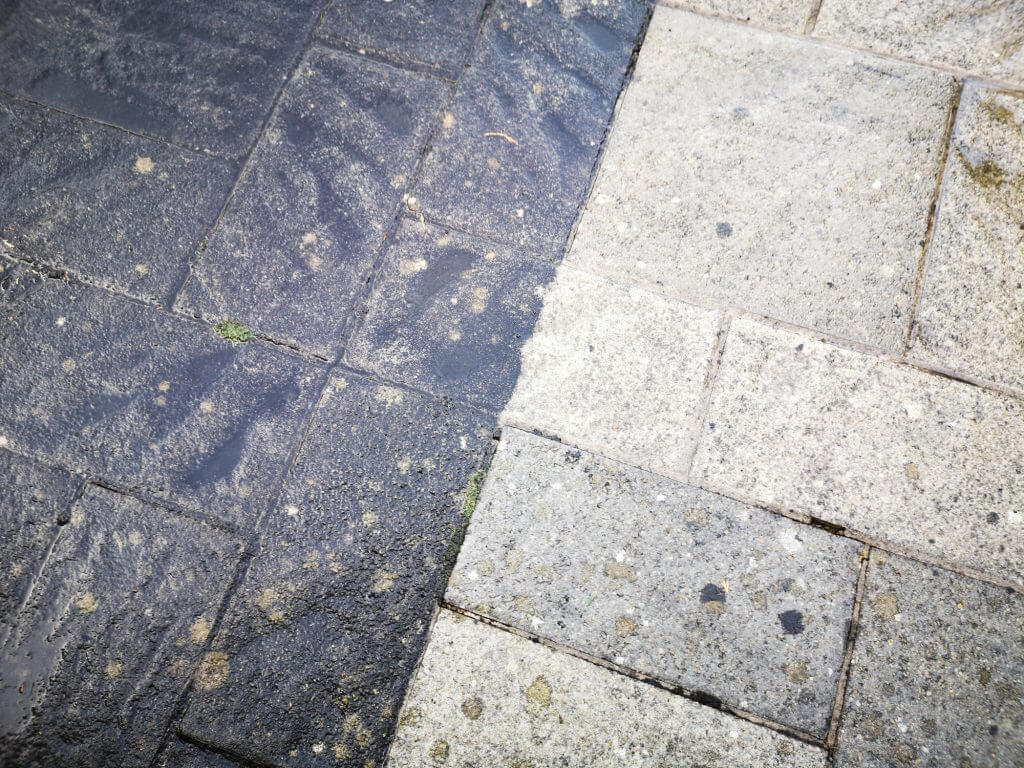Well-maintained and clean pavers bring so much personality and appeal to the property. Since pavers are also there for practical reasons, they will inevitably get different kinds of stains.
For oil or grease stains on pavers, use a detergent or specially formulated degreaser. For paints, there are different paint removing chemicals and mechanical methods. Leaf stains can be removed with bleach. Vinegar, lemon, or other acids can remove rust stains. Most stains on pavers can be resolved with natural, commercial chemical, or mechanical means.

Oil Stains
Oil and grease are unavoidable on pavers in driveways, and areas used for dining and barbecues.
You may need to use different methods or cleaners for food and non-food oil stains.
Food Oil Stains
For food oil stains, you can try using readily-available household items first, such as:
- Liquid Dish Soap
- Baking soda
- Vinegar
- Acetone
- Bleach
These also work for other food stains such as ketchup, wine, mustard, and sauces.
Blot out the excess from the pavers, then apply the product.
You may need to agitate and work it into the pavement using a stiff brush to effectively remove the stain.
Rinse and repeat if necessary.
Non-food Oil Stains
For engine grease, brake oil, and other non-food oil stains, it is better to use commercial oil removers or detergents with degreasers.
Use warm or hot water when rinsing them off to help remove more grease.
Paint Stains
When paint gets on the pavers, the sooner you remove it, the better the results.
For very recent paint spills
Blot out any excess paint that is pooling on top of the pavers. You can use a throwaway cloth for this.
If the paint is water-based, you can use warm water and a stiff brush to remove the rest of the paint.
If the paint is oil-based, you can use acetone or paint thinners. Work it into the pavers, wipe the excess and rinse off. Repeat if needed.
For dried paint
If the paint has been on the pavers long enough for it to dry, there are several methods you can try.
Step 1 – Paint remover and a stiff brush
If the stain is manageable enough, you can use a stiff brush and paint remover.
Apply the paint remover on the stain and let it sit for the required time as indicated by the manufacturer.
Scrub off the remaining stain using a hard-bristled brush.
Step 2 – Pressure washer
Pressure washers can remove paint off pavers. However, ordinary pressure washers for home use may not have enough force, especially if the paint has been on the pavers for a long time.
A pressure cleaner with at least 3000 psi or higher will be more effective in removing paint stains off the pavers.
Rust Stains
Rust can be an issue on the pavers due to several factors such as metal furniture, fertilisers, water with high mineral content, or other metal left rusting on the pavers.
Acids like white vinegar or lemon juice could be effective for smaller stains. Pour it over the stain and let it sit for a few minutes. Scrub and rinse off.
There are many rust-removers available at your local hardware supply store.
Each one will have different instructions, so make sure to read and follow the manufacturer’s guide carefully.
Rust removers are usually applied and then scrubbed using a stiff brush, then rinsed off.
You may need to re-apply the chemical and repeat the process to remove the rust completely.
Leaf Stains
Since pavers are usually part of the overall landscape and design of the home, it is generally placed near areas with vegetation.
Having plants, grass, and trees nearby may leave leaf and grass stains on the pavers.
Chlorine or bleach is effective in removing leaf stains on pavers.
Make sure to first test in a small area to see if the bleach will not damage your pavers.
Dilute one part chlorine bleach in 10 parts water. Use less water for more stubborn stains.
Pour the solution on the paver and let it sit for about 30 minutes.
Scrub using a medium to hard-bristled brush and rinse.
Rubber Skid Marks
Pavers on driveways can also get skid marks from tires.
Skid marks can be removed using detergent and a stiff brush. Apply the cleanser and add a little water and agitate using a stiff brush.
Continue brushing until the marks are removed, then rinse off with water.
There are also rubber and tar removers available to remove the stains on your pavers. Follow the manufacturer’s instructions.
Caulking or Chewing Gum
Even though caulking is different from chewing gum, the same method applies to remove them from pavers.
To remove hardened caulking or gum off of the pavers, scrape it off.
For caulking and gum embedded in the paver, use a cotton cloth dipped in denatured alcohol. Put the cloth with alcohol on the spot and let it sit for a few minutes.
Remove the cloth and scrub off the caulking or gum using a hard brush, and rinse with water.
Moss, Lichens, and Algae
Moss, lichens, and algae are unsightly growth on the pavers. They love moisture and are often problematic starting from spring, as the weather gets damper and more humid.
There are several ways and products you can use to remove them, such as:
- Vinegar
- Baking Soda
- Soda Crystals
- Bleach
- Muriatic Acid
- Hot water
- Commercial moss and algae removers
Visit our page for a more detailed guide on How to Remove Moss from Pavers.
If you need help removing stains from your pavers, reach out to Harwood’s Garden Supplies today. More information about our pressure cleaning service here.
[elementor-template id=”5226″]
